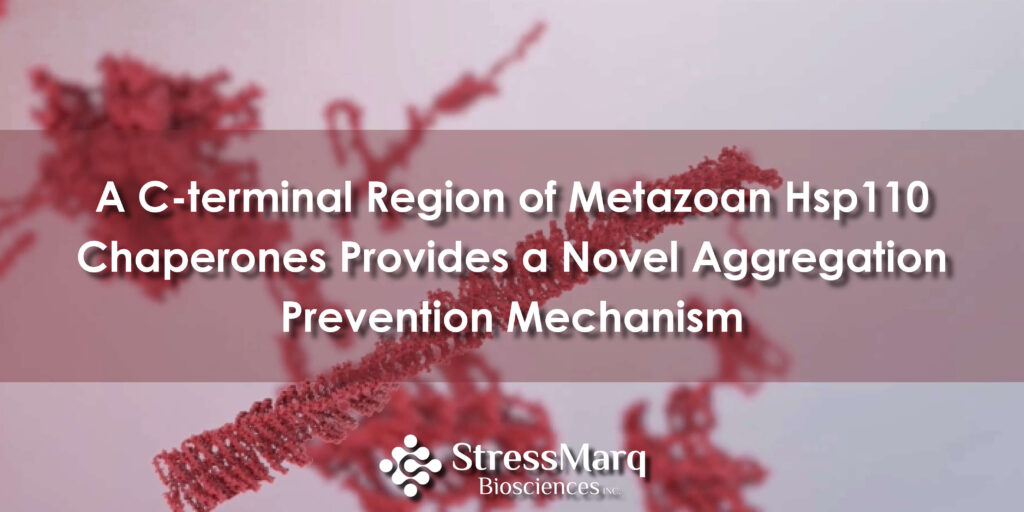Study Reveals that a C-terminal Region of Metazoan Hsp110 Chaperones Provides a Novel Aggregation Prevention Mechanism
A recent publication citing the use of StressMarq’s Alpha Synuclein Monomers and Pre-Formed Fibrils shows a previously undiscovered substrate binding site in the C-terminus of both Drosophila Hsp110 and its human homologs (Hsp105α and Apg-1) to prevent protein aggregation in vitro. It is suggested that this property of Hsp110 could be exploited for therapeutic benefit in treating conditions such as Alzheimer’s disease and Parkinson’s disease1.
Molecular chaperones are key mediators of proteostasis
Protein homeostasis (proteostasis) networks monitor protein quality at every stage of the protein life cycle – from synthesis and folding, through trafficking and degradation2. They are critical to ensuring that proteins function correctly and comprise a vast multitude of factors, including many molecular chaperones. Under physiological conditions, molecular chaperones support protein homeostasis by preventing or reversing protein aggregation that can occur when polypeptides are folded incorrectly. Because the accumulation of cytotoxic protein aggregates in neuronal cells is a classic hallmark of neurodegenerative disorders such as Alzheimer’s disease and Parkinson’s disease, molecular chaperones are widely recognized as a potential target for therapeutic intervention3,4.
Hsp70 molecular chaperones are regulated by the Hsp110 family
Heat shock proteins of 70kDa (Hsp70) are a major family of molecular chaperones. They have an N-terminal ATPase domain, a substrate-binding domain (SBD) with affinity to hydrophobic peptide segments exposed in non‐native proteins, and a C-terminal domain that helps trap the bound substrate in place5,6. They are regulated by members of the Hsp110 family, which act as nucleotide exchange factors (NEFs) to remove ADP after ATP hydrolysis, thereby enabling a new cycle of interaction between Hsp70 and non‐native protein substrate to take place. Hsp110s are structurally similar to Hsp70 but feature a more divergent ATPase domain and contain insertions of varying lengths in the C‐terminal domain5.
Hsp110s are more than just NEFs
Although the NEF activity of Hsp110s has been well-characterized, the authors of the study hypothesized that these proteins might also provide a protective ‘holdase’ function. Specifically, they suggested (based on previous work performed in Drosophila) that Hsp110s could use the SBD-β subdomain to bind unfolded polypeptides and prevent their aggregation. To test this theory, an in vitro protein aggregation assay was used to determine whether Drosophila Hsp110 could prevent the model substrate citrate synthase (CS) from aggregating. Surprisingly, while results showed Hsp110 to suppress CS aggregation in a dose dependent manner, removal of the SBD-β subdomain was discovered to have little effect.
A previously unstudied region of Hsp110 contributes to chaperone activity
Having found the SBD-β subdomain to be expendable for holdase activity, the authors postulated that Hsp110 might contain an additional substrate binding site. Drawing on the observation that Drosophila Hsp110 possesses a carboxyl-terminal extension (C-term) of approximately 106 additional amino acids that is lacking in yeast Hsp110 (Sse1), they fused this region of the protein to the N-terminal domain and tested the resultant hybrid for holdase function. The hybrid protein exhibited potent aggregate suppression activity and the holdase activity was subsequently mapped to 53 amino acids comprising a predicted intrinsically disordered region (IDR) at the extreme carboxyl-terminus.
The IDR-containing C-terminal extension is conserved in metazoan Hsp110s
Clustal Omega sequence alignment showed the novel C-terminal extension to be present in several metazoan Hsp110 homologs, including the human homologs Apg-1and Hsp105α. Hybrid constructs of the human proteins were therefore generated by fusing the C-terminus of Apg-1 or Hsp105α to the N-terminal domain of the Drosophila protein and both were shown to prevent protein aggregation. New protein hybrids were then produced using the N-terminal domain of Drosophila Hsp110 and the predicted IDR of Drosophila Hsp110 or human Hsp105α and were assessed for their activity on proteins implicated in human neurodegenerative disease. This included the use of Thioflavin T binding assays to follow fibrilization of Aβ42 or α-synuclein over time.
StressMarq products support seminal research
Fibrilization of alpha-synuclein is often followed in vitro by measuring the binding of the fluorescent dye Thioflavin T to beta sheet-rich structures (such as those in alpha synuclein fibrils). It typically requires seeding by preformed fibrils (PFF), with increased fluorescence intensity being indicative of fibrilization taking place. Using StressMarq’s Alpha Synuclein Monomers and Pre-Formed Fibrils, the authors of the study showed both the new hybrid proteins to allow a small increase in fluorescence over the first hour of the experiment but little further increase, demonstrating highly effective suppression of alpha-synuclein fibrilization. This highlights the potential for these proteins to be developed into therapeutic tools for blocking or delaying protein aggregation in several neurodegenerative disorders.
To learn more about how our Alpha Synuclein Monomers and Pre-Formed Fibrils can be used for neurodegenerative disease modeling, take a look at our video.
- https://www.biorxiv.org/content/10.1101/2021.01.13.426581v1
- Protein homeostasis from the outside in, Webster BM et al, Nat Cell Biol. 2020 ug;22(8):911-912
- Therapeutic targeting of the endoplasmic reticulum in Alzheimer’s disease, Chadwick W et al, Curr Alzheimer Res. 2012 Jan;9(1):110-9
- Disruption of Protein Quality Control in Parkinson’s Disease, Cook C et al, Cold Spring Harb Perspect Med. 2012 May 2(5)
- Molecular chaperones of the Hsp110 family act as nucleotide exchange factors of Hsp70s, Dragovic Z et al, EMBO J. 2006 Jun 7;25(11):2519-28
- Hsp70 Structure, Function, Regulation and Influence on Yeast Prions, Sharma D and Masison DC, Protein Pept Lett. 2009;16(6):571-81


Leave a Reply